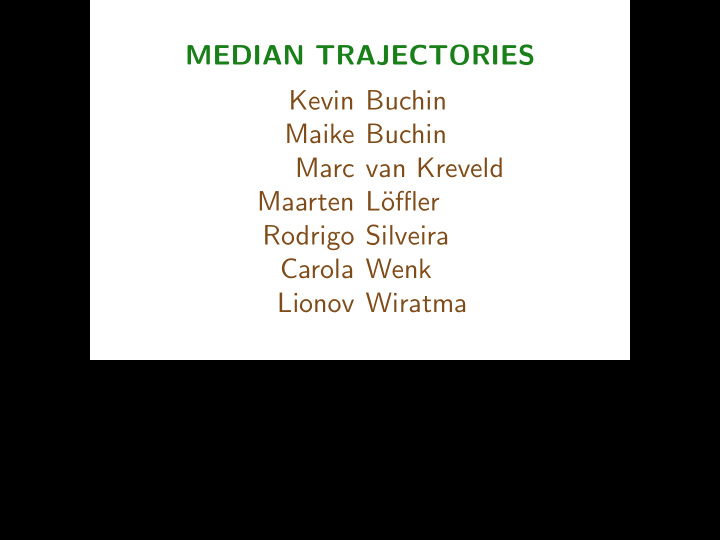



SHORTCUTS • Problem • Simple median may miss large parts of the input trajectories • Solution • Plant a tree
SHORTCUTS • Problem • Simple median may miss large parts of the input trajectories • Solution • Place a pole
SHORTCUTS • Problem • Simple median may miss large parts of the input trajectories • Solution • Place a pole
SHORTCUTS • Problem • Simple median may miss large parts of the input trajectories • Solution • Place a pole • Require the median to go around it
SHORTCUTS • Problem • Simple median may miss large parts of the input trajectories • Solution • Place a pole • Require the median to go around it
SHORTCUTS • Problem • Simple median may miss large parts of the input trajectories • Solution • Place a pole • Require the median to go around it • ... how do we steer the median correctly around these poles?
HOMOTOPY
HOMOTOPY • Ingredients
HOMOTOPY • Ingredients • One punctured plane
HOMOTOPY • Ingredients • One punctured plane
HOMOTOPY • Ingredients • One punctured plane • Two points s and t in the plane
HOMOTOPY • Ingredients • One punctured plane • Two points s and t in the plane • Two continuous curves from s to t
HOMOTOPY • Ingredients • One punctured plane • Two points s and t in the plane • Two continuous curves from s to t
HOMOTOPY • Ingredients • One punctured plane • Two points s and t in the plane • Two continuous curves from s to t • The curves are homotopic if ...
HOMOTOPY • Ingredients • One punctured plane • Two points s and t in the plane • Two continuous curves from s to t • The curves are homotopic if ... • ... one can be smoothly transformed into the other
HOMOTOPY • Ingredients • One punctured plane • Two points s and t in the plane • Two continuous curves from s to t • The curves are homotopic if ... • ... one can be smoothly transformed into the other • ... the concatenation is a closed curve that can be contracted to a point
HOMOTOPY • Ingredients • One punctured plane • Two points s and t in the plane • Two continuous curves from s to t • The curves are homotopic if ... • ... one can be smoothly transformed into the other • ... the concatenation is a closed curve that can be contracted to a point
HOMOTOPY • Ingredients • One punctured plane • Two points s and t in the plane • Two continuous curves from s to t • The curves are homotopic if ... • ... one can be smoothly transformed into the other • ... the concatenation is a closed curve that can be contracted to a point
HOMOTOPY • Ingredients • One punctured plane • Two points s and t in the plane • Two continuous curves from s to t • The curves are homotopic if ... • ... one can be smoothly transformed into the other • ... the concatenation is a closed curve that can be contracted to a point
HOMOTOPY • Ingredients • One punctured plane • Two points s and t in the plane • Two continuous curves from s to t • The curves are homotopic if ... • ... one can be smoothly transformed into the other • ... the concatenation is a closed curve that can be contracted to a point
HOMOTOPY • Ingredients • One punctured plane • Two points s and t in the plane • Two continuous curves from s to t • The curves are homotopic if ... • ... one can be smoothly transformed into the other • ... the concatenation is a closed curve that can be contracted to a point
HOMOTOPY • Ingredients • One punctured plane • Two points s and t in the plane • Two continuous curves from s to t • The curves are homotopic if ... • ... one can be smoothly transformed into the other • ... the concatenation is a closed curve that can be contracted to a point
HOMOTOPY • Ingredients • One punctured plane • Two points s and t in the plane • Two continuous curves from s to t • The curves are homotopic if ... • ... one can be smoothly transformed into the other • ... the concatenation is a closed curve that can be contracted to a point
COVERING SPACE
COVERING SPACE • Consider a point in a space E
COVERING SPACE • Consider a point in a space E
COVERING SPACE • Consider a point in a space E • Make a copy of the point for each homotopically different way to reach it
COVERING SPACE • Consider a point in a space E • Make a copy of the point for each homotopically different way to reach it
COVERING SPACE • Consider a point in a space E • Make a copy of the point for each homotopically different way to reach it
COVERING SPACE • Consider a point in a space E • Make a copy of the point for each homotopically different way to reach it
COVERING SPACE • Consider a point in a space E • Make a copy of the point for each homotopically different way to reach it • The resulting space E ′ is called the covering space of E
COVERING SPACE • Consider a point in a space E • Make a copy of the point for each homotopically different way to reach it • The resulting space E ′ is called the covering space of E
COVERING SPACE • Consider a point in a space E • Make a copy of the point for each homotopically different way to reach it • The resulting space E ′ is called the covering space of E
Recommend
More recommend